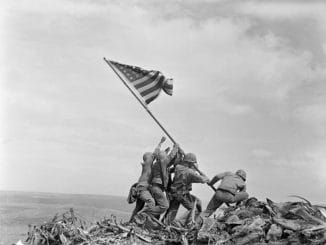The Battle of Iwo Jima (19 February – 26 March 1945) was a major battle in which the United States Marine Corps and Navy landed on and eventually captured the island of Iwo Jima from the Imperial Japanese Army (IJA) during World War II.
Lying roughly halfway between American Army Airforce bases in the Mariana Islands and the Japanese islands, the military base on Iwo Jima gave the Japanese an ability to send early air raid warnings to the Japanese mainland and launch fighters from its airfields to intercept raids.
The American invasion, designated Operation Detachment, had the purpose of capturing the island with its two airfields: South Field and Central Field The strategic objectives were twofold: the first was to provide an emergency landing strip for battle-damaged B-29s unable to make it back to US air bases in the Marianas Tinian, Saipan, Guam. The second was to provide air fields for fighter escorts, long-range P-51s, to provide fighter coverage to the bombers.
The five-week battle saw some of the fiercest and bloodiest fighting of the Pacific War.


